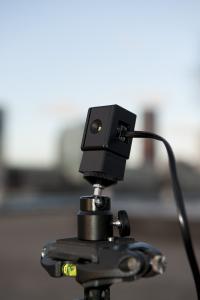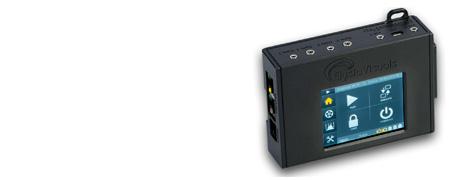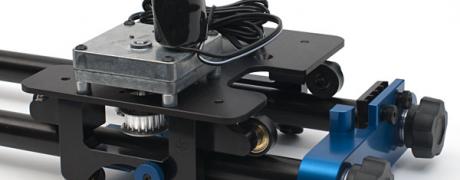A word about the light sensor and automatic exposure
 This chapter gives you more details about the external light sensor. It also describes how to use the auto exposure mode of the RamperPro where the images from your camera are analyzed during a timelapse shoot. The combination of the light sensor and the auto mode are described by explaining what is happening during a sunset.
This chapter gives you more details about the external light sensor. It also describes how to use the auto exposure mode of the RamperPro where the images from your camera are analyzed during a timelapse shoot. The combination of the light sensor and the auto mode are described by explaining what is happening during a sunset.
The RamperPro can be used together with the advanced digital light sensor. The light sensor is used to measure the trend in light. The RamperPro samples the ambient light over a specific time period. These samples are then used to calculate how fast it is getting light during a sunrise or how fast it is getting dark during a sunset. There are many misunderstandings about what the light sensor can do. The following is a list of what the light sensor is NOT doing when it is connected to the RamperPro:
- The light sensor is not used to determine the exposure of your images. The exposure of your images is only indirectly influenced by the light sensor because the calculated trend in ambient light is used by the ramping algorithm.
- The light sensor algorithm is not following fluctuations in ambient light. You set the RamperPro to either ramp a sunset of sunrise based on the parameters. This means that the output of the light sensor is only taken into account when the measured light change direction (for example a sunset) is in line with the runtime parameters. A sudden rise in sunlight during a sunset (because of disappearing clouds) is corrected by the mathematics behind the light sensor. It would give strange results when the RamperPro is following any fluctuation in the ambient light.
The above points already state that the light sensor algorithm is not continuously reacting to any change in light. The time per stop that is calculated is an average over 10 minutes. This results in only small, regular, changes in the ramping curve. The results of the light sensor will give very good results when used properly because the sensor is gradually following the sunset or sunrise.
This may sound as a limited benefit when you use the external light sensor. But that is not true when you understand what the sensor can do and what it cannot do. The following examples are based on a sunset, but the same is true the other way around for a sunrise.
One challenge during the ramping of a sunset is when do you know when to start ramping? This is one thing that the light sensor can do very accurately for you. Suppose that you want to start your timelapse one hour before sunset. That is a situation where the amount of ambient light is already declining; it’s getting dark (a bit). The light sensor will measure this and this will result in a very high time per stop value. You can easily measure 30 to 40 minutes per stop when you start to measure light one hour before a sunset. This means that the RamperPro will need 30 to 40 minutes to ramp one stop away from the start exposure. The measured time per stop will become shorter and shorter when the sun really sets. A value of 10 minutes per stop at the moment of the actual sunset is what we have measured on many occasions. This means that the RamperPro will speed up the ramping speed . The sunset is therefore automatically detected by the RamperPro. It will very gradually ramp 60 minutes before a sunset, but it will ramp faster during or after the sunset.
The “problem” starts after the sunset because that leads to the following situation:
- It will eventually get too dark for the light sensor to return any usable measurements.
- The time per stop will get s and longer after the sunset. It will take considerable time before it is really, really dark for example.
It is very easy to get over exposed images when you set the wrong end exposure. Say you want an end exposure of 10 seconds at ISO 1600 when you want to ramp for bright day light to stars. It will take quite some time to reach a dark sky with stars. This example can easily cover 16 stops depending on the start situation. Let say that we have an average time per stop of 7 minutes as a result of the light sensor (remember that you can set a minimum value to restrict it in the runtime parameters). This would mean that the total runtime to reach the end exposure is 16 stops * 7 minutes = 1 hour and 52 minutes. This will give great results when you really need 10 seconds at ISO 1600 at that moment in time. But you will over exposure your images when it takes 3 hours before the ambient light reached this exposure value. You are ramping to your end situation too fast!
This is where a very exciting new feature of the RamperPro kicks in “Auto Exposure Mode”. This mode will download jpeg images from the camera to the RamperPro. These images are analyzed by evaluating the histogram of these jpeg images. This gives two ways that we can measure light, the trend in light with the light sensor (available directly when you start) and the individual exposures of the images that you are really shooting.
The histogram data of the individual images is used by the RamperPro to influence the ramping speed. It can for example ramp a bit slower when the histogram indicates that over exposure is almost going to occur. This will make sure that you can reach your desired end exposure without having the risk of blown out images.
We now have the best of both worlds. The light sensor will make sure that we start to ramp by following the changing light of a sunset. The histogram analysis algorithm will make sure that we will never have over exposed images by damping the ramping speed when needed.
The auto exposure mode comes at a, slight, cost. It takes time to download the jpeg images from the camera to the RamperPro. It also takes to before the RamperPro has analyzed the downloaded image. A highly compressed 36MP image from a D800 is still a few megabytes. Analyzing these 36 mega pixels is memory and calculation intensive. This means that you will need an interval of around 10 seconds to make sure that these operations can be performed in time.
The auto mode can overrule the end exposure and end ISO value. Let's say that you have set an end exposure or 20 seconds at ISO 1600 but you are shooting in a city. The RamperPro will then most probably never reach this end exposure when it is running in auto mode. The histogram analysis will make sure that the RamperPro will stop ramping when the proper exposure is reached.


